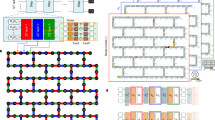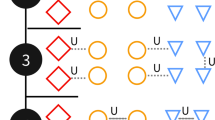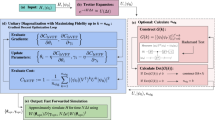Abstract
Noise in existing quantum processors only enables an approximation to ideal quantum computation. However, for the computation of expectation values, these approximations can be improved by error mitigation. This has been experimentally demonstrated in small systems but the scaling of these methods to larger circuit volumes remains unknown. Here we demonstrate the utility of zero-noise extrapolation for practically relevant quantum circuits using up to 26 qubits, circuit depths of 120 and 1,080 CNOT gates. We study the scaling of the method for canonical examples of product states and entangling Clifford circuits of increasing size, and extend it to simulating the quench dynamics of two-dimensional Ising spin lattices with varying couplings. These experiments reveal that the accuracy of physically relevant observables after error mitigation substantially exceeds previously expected values. Furthermore, we show that the efficacy of error mitigation is greatly enhanced by additional error suppression techniques and native gate decomposition that reduce the circuit time. By combining these methods, the accuracy of our quantum simulation surpasses the classical approximations obtained from an established tensor network method. These results establish the potential of a useful quantum advantage using noisy, digital quantum processors.
This is a preview of subscription content, access via your institution
Access options
Access Nature and 54 other Nature Portfolio journals
Get Nature+, our best-value online-access subscription
$29.99 / 30 days
cancel any time
Subscribe to this journal
Receive 12 print issues and online access
$209.00 per year
only $17.42 per issue
Buy this article
- Purchase on Springer Link
- Instant access to full article PDF
Prices may be subject to local taxes which are calculated during checkout



Similar content being viewed by others
Data availability
Source data are available for this paper. All other data that support the plots within this Article and other findings of this study are available from the corresponding author upon reasonable request.
References
Shor, P. W. Scheme for reducing decoherence in quantum computer memory. Phys. Rev. A 52, R2493 (1995).
Steane, A. M. Error correcting codes in quantum theory. Phys. Rev. Lett. 77, 793–797 (1996).
Zhang, E. J. et al. High-performance superconducting quantum processors via laser annealing of transmon qubits. Sci. Adv. 8, eabi6690 (2022).
Arute, F. et al. Quantum supremacy using a programmable superconducting processor. Nature 574, 505–510 (2019).
Wu, Y. et al. Strong quantum computational advantage using a superconducting quantum processor. Phys. Rev. Lett. 127, 180501 (2021).
Bravyi, S., Gosset, D., Koenig, R. & Tomamichel, M. Quantum advantage with noisy shallow circuits. Nat. Phys. 16, 1040–1045 (2020).
Temme, K., Bravyi, S. & Gambetta, J. M. Error mitigation for short-depth quantum circuits. Phys. Rev. Lett. 119, 180509 (2017).
Li, Y. & Benjamin, S. C. Efficient variational quantum simulator incorporating active error minimization. Phys. Rev. X 7, 021050 (2017).
Kandala, A. et al. Error mitigation extends the computational reach of a noisy quantum processor. Nature 567, 491–495 (2019).
Peruzzo, A. et al. A variational eigenvalue solver on a photonic quantum processor. Nat. Commun. 5, 4213 (2014).
Kandala, A. et al. Hardware-efficient variational quantum eigensolver for small molecules and quantum magnets. Nature 549, 242–246 (2017).
Havlíček, V. et al. Supervised learning with quantum-enhanced feature spaces. Nature 567, 209–212 (2019).
Schuld, M. & Killoran, N. Quantum machine learning in feature Hilbert spaces. Phys. Rev. Lett. 122, 040504 (2019).
Dumitrescu, E. F. et al. Cloud quantum computing of an atomic nucleus. Phys. Rev. Lett. 120, 210501 (2018).
Song, C. et al. Quantum computation with universal error mitigation on a superconducting quantum processor. Sci. Adv. 5, eaaw5686 (2019).
Zhang, S. et al. Error-mitigated quantum gates exceeding physical fidelities in a trapped-ion system. Nat. Commun. 11, 587 (2020).
Koczor, B. Exponential error suppression for near-term quantum devices. Phys. Rev. X 11, 031057 (2021).
Huggins, W. J. et al. Virtual distillation for quantum error mitigation. Phys. Rev. X 11, 041036 (2021).
McClean, J. R., Kimchi-Schwartz, M. E., Carter, J. & de Jong, W. A. Hybrid quantum-classical hierarchy for mitigation of decoherence and determination of excited states. Phys. Rev. A 95, 042308 (2017).
Bonet-Monroig, X., Sagastizabal, R., Singh, M. & O’Brien, T. E. Low-cost error mitigation by symmetry verification. Phys. Rev. A 98, 062339 (2018).
McArdle, S., Yuan, X. & Benjamin, S. Error-mitigated digital quantum simulation. Phys. Rev. Lett. 122, 180501 (2019).
He, A., Nachman, B., de Jong, W. A. & Bauer, C. W. Zero-noise extrapolation for quantum-gate error mitigation with identity insertions. Phys. Rev. A 102, 012426 (2020).
Lowe, A. et al. Unified approach to data-driven quantum error mitigation. Phys. Rev. Res. 3, 033098 (2021).
Czarnik, P., Arrasmith, A., Coles, P. J. & Cincio, L. Error mitigation with Clifford quantum-circuit data. Quantum 5, 592 (2021).
Koch, J. et al. Charge-insensitive qubit design derived from the Cooper pair box. Phys. Rev. A 76, 042319 (2007).
Chow, J. M. et al. Simple all-microwave entangling gate for fixed-frequency superconducting qubits. Phys. Rev. Lett. 107, 080502 (2011).
Gordon, R. T. et al. Environmental radiation impact on lifetimes and quasiparticle tunneling rates of fixed-frequency transmon qubits. Appl. Phys. Lett. 120, 074002 (2022).
Wei, K. X. et al. Hamiltonian engineering with multicolor rives for fast entangling gates and quantum crosstalk cancellation. Phys. Rev. Lett. 129, 060501 (2022).
Jurcevic, P. et al. Demonstration of quantum volume 64 on a superconducting quantum computing system. Quantum Sci. Technol. 6, 025020 (2021).
Murg, V., Verstraete, F. & Cirac, J. I. Variational study of hard-core bosons in a two-dimensional optical lattice using projected entangled pair states. Phys. Rev. A 75, 033605 (2007).
Chamberland, C., Zhu, G., Yoder, T. J., Hertzberg, J. B. & Cross, A. W. Topological and subsystem codes on low-degree graphs with flag qubits. Phys. Rev. X 10, 011022 (2020).
Hertzberg, J. B. et al. Laser-annealing Josephson junctions for yielding scaled-up superconducting quantum processors. npj Quantum Inf. 7, 129 (2021).
Carroll, M., Rosenblatt, S., Jurcevic, P., Lauer, I. & Kandala, A. Dynamics of superconducting qubit relaxation times. npj Quantum Inf. 8, 132 (2022).
Sachdev, S. Quantum phase transitions. Phys. World 12, 33 (1999).
Browaeys, A. & Lahaye, T. Many-body physics with individually controlled Rydberg atoms. Nat. Phys. 16, 132–142 (2020).
Bernien, H. et al. Probing many-body dynamics on a 51-atom quantum simulator. Nature 551, 579–584 (2017).
Zhang, J. et al. Observation of a many-body dynamical phase transition with a 53-qubit quantum simulator. Nature 551, 601–604 (2017).
Smith, A., Kim, M. S., Pollmann, F. & Knolle, J. Simulating quantum many-body dynamics on a current digital quantum computer. npj Quantum Inf. 5, 106 (2019).
Sopena, A., Gordon, M. H., Sierra, G. & López, E. Simulating quench dynamics on a digital quantum computer with data-driven error mitigation. Quantum Sci. Technol. 6, 045003 (2021).
Vovrosh, J. et al. Simple mitigation of global depolarizing errors in quantum simulations. Phys. Rev. E 104, 035309 (2021).
Urbanek, M. et al. Mitigating depolarizing noise on quantum computers with noise-estimation circuits. Phys. Rev. Lett. 127, 270502 (2021).
Childs, A. M., Maslov, D., Nam, Y., Ross, N. J. & Su, Y. Toward the first quantum simulation with quantum speedup. Proc. Natl Acad. Sci. USA 115, 9456–9461 (2018).
Nielsen, M. A. & Chuang, I. L. Quantum Computation and Quantum Information: 10th Anniversary Edition (Cambridge Univ. Press, 2010).
Moyal, J. E. Quantum mechanics as a statistical theory. Math. Proc. Camb. Philos. Soc. 45, 99–124 (1949).
Keldysh, L. V. et al. Diagram technique for nonequilibrium processes. Sov. Phys. JETP 20, 1018–1026 (1965).
White, S. R. & Feiguin, A. E. Real-time evolution using the density matrix renormalization group. Phys. Rev. Lett. 93, 076401 (2004).
Orús, R. A practical introduction to tensor networks: matrix product states and projected entangled pair states. Ann. Phys. 349, 117–158 (2014).
Vidal, G. Efficient classical simulation of slightly entangled quantum computations. Phys. Rev. Lett. 91, 147902 (2003).
Verstraete, F. & Cirac, J. I. Renormalization algorithms for quantum-many body systems in two and higher dimensions. Preprint at https://arxiv.org/abs/cond-mat/0407066 (2004).
Verstraete, F., Murg, V. & Cirac, J. I. Matrix product states, projected entangled pair states, and variational renormalization group methods for quantum spin systems. Adv. Phys. 57, 143–224 (2008).
Schuch, N., Wolf, M. M., Vollbrecht, K. G. H. & Cirac, J. I. On entropy growth and the hardness of simulating time evolution. New J. Phys. 10, 033032 (2008).
Bennett, C. H. et al. Purification of noisy entanglement and faithful teleportation via noisy channels. Phys. Rev. Lett. 76, 722–725 (1996).
Knill, E. Fault-tolerant postselected quantum computation: threshold analysis. Preprint at https://arxiv.org/abs/quant-ph/0404104 (2004).
Wallman, J. J. & Emerson, J. Noise tailoring for scalable quantum computation via randomized compiling. Phys. Rev. A 94, 052325 (2016).
Hashim, A. et al. Randomized compiling for scalable quantum computing on a noisy superconducting quantum processor. Phys. Rev. X 11, 041039 (2021).
Earnest, N., Tornow, C. & Egger, D. J. Pulse-efficient circuit transpilation for quantum applications on cross-resonance-based hardware. Phys. Rev. Res. 3, 043088 (2021).
Stenger, J. P. T., Bronn, N. T., Egger, D. J. & Pekker, D. Simulating the dynamics of braiding of Majorana zero modes using an IBM quantum computer. Phys. Rev. Res. 3, 033171 (2021).
Sundaresan, N. et al. Reducing unitary and spectator errors in cross resonance with optimized rotary echoes. PRX Quantum 1, 020318 (2020).
Acknowledgements
We thank I. Lauer for contributions towards two-qubit gate calibration, and D. T. McClure and N. Sundaresan for valuable discussions on the device bring-up.
Author information
Authors and Affiliations
Contributions
A.K. and K.T. designed the experiments. Y.K. and A.K. performed the experiments. C.J.W. and T.J.Y. ran the noisy simulations. S.T.M. provided the code for implementing Pauli twirling. K.T. ran the tensor network simulations. Y.K., C.J.W., T.J.Y., J.M.G., K.T. and A.K. analysed the data and wrote the paper.
Corresponding authors
Ethics declarations
Competing interests
The authors declare no competing interests.
Peer review
Peer review information
Nature Physics thanks Xiao Yuan, Jinzhao Sun, Yukun Zhang and the other, anonymous, reviewer(s) for their contribution to the peer review of this work.
Additional information
Publisher’s note Springer Nature remains neutral with regard to jurisdictional claims in published maps and institutional affiliations.
Supplementary information
Supplementary Information
Supplementary Sections I–VI, Figs. 1–10 and Table 1.
Source data
Source Data Fig. 2
Source data for Fig. 2 in .csv format along with a .ipynb file used to draw each plot.
Source Data Fig. 3
Source data for Fig. 3 in .csv format along with a .ipynb file used to draw each plot.
Rights and permissions
Springer Nature or its licensor (e.g. a society or other partner) holds exclusive rights to this article under a publishing agreement with the author(s) or other rightsholder(s); author self-archiving of the accepted manuscript version of this article is solely governed by the terms of such publishing agreement and applicable law.
About this article
Cite this article
Kim, Y., Wood, C.J., Yoder, T.J. et al. Scalable error mitigation for noisy quantum circuits produces competitive expectation values. Nat. Phys. 19, 752–759 (2023). https://doi.org/10.1038/s41567-022-01914-3
Received:
Accepted:
Published:
Issue Date:
DOI: https://doi.org/10.1038/s41567-022-01914-3
This article is cited by
-
Short-depth QAOA circuits and quantum annealing on higher-order ising models
npj Quantum Information (2024)
-
Quantum error mitigation in the regime of high noise using deep neural network: Trotterized dynamics
Quantum Information Processing (2024)
-
Error-mitigated quantum simulation of interacting fermions with trapped ions
npj Quantum Information (2023)
-
Probabilistic error cancellation with sparse Pauli–Lindblad models on noisy quantum processors
Nature Physics (2023)
-
Adaptive quantum error mitigation using pulse-based inverse evolutions
npj Quantum Information (2023)



